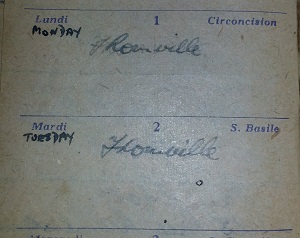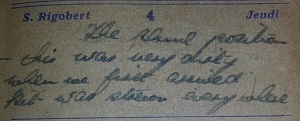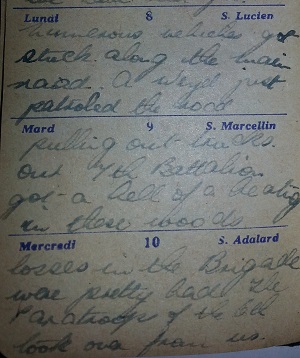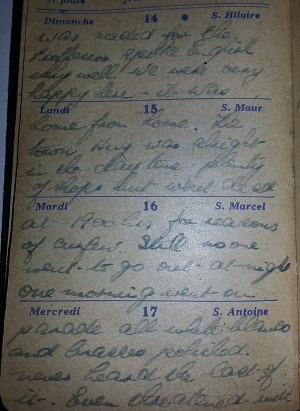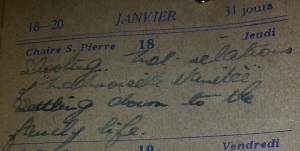The Ardennes operations
(16th December 1944 to 17th January 1945)
The diary starts in the middle of the Ardennes operations. The Ardennes offensive was Hitlers attempt to stop the Allied progress in the West:
"By mid-December [1944] the Germans had succeeded - thanks to the heavy autmn rains and severe winter weather - in slowing the Allied advance, in forming a solid front and in limiting the invasion of the Fatherland to minor areas. [...]C.N. Barclay also describes the role of the 53rd Division in fighting the German offensive:
The German high command had succeeded in refitting about eight Panzer Divisions in the West, to a scale of approximately 100 tanks each, of the latest 'Panther' and 'Tiger' types. The enemy had also managed to increase his total Field Force in the West from the equivalent of some 23 Divisions in August, to about 70 Divisions in December.
Hitler planned to risk the reserves thus built up in an all-out offensive which, by means of a surprise thrust, was to drive across the River Meuse towards Antwerp and deprive the Allies of their main bases at Liege, Brussels and Antwerp." (Barc56, p.98).
"General Eisenhower's plan to deal with the situation was to halt the enemy advance before it crossed the Meuse and to counter-attack the salient with the First United States Army from the North and the Third United States Army from he South. [...]Since the diary only covers 1945, the events during the first half of the Ardennes Offensive are not included.
In this plan the XXX British Corps (43rd Wessex, 51st Highland and 53rd Welsh Divisions - plus three Armoured Brigades and other Corps Troops), under Lieut-General Sir Brian Horrocks, was given the immediate task of securing the Meuse crossings between Namur and Liege." (Barc56, p.99)
1st-10th January 1945: Fronville, Hotton, bad weather conditions
| Fronville | |
|
East of Fronville. Took over from 84 Yanks Division. |
|
| The same position. This was very dirty when we first arrived. Kit was strewn everywhere. | |
| C.P. was in the next position - South of Hotton a small log cabin being unable to dig deep we built it half above ground. Snow and blizzards on this position. It was like venturing forth captain oates style when we left the C.P. for anything. | |
| Our bivies looked like igloos in no time. Worse weather we have had yet. | |
| Numerous vehicles got stuck along the main road. A Weasel just patroled the road pulling out trucks. Our 7th Battalion got a hell of a beating in these woods. Losses in the Brigade were pretty bad. The paratroops of the 6th took over from us. |
At the beginning of January 1945 - in the middle of the German Ardennes Offensive - the 53rd welsh division was situated in the area around Marche-en-Famenne:
"When it became apparent that the German offensive had shot its bolt the main task of the XXX British Corps was to relieve American troops on the Meuse, and at the apex of the bulge, and thus release them from offensive operations against the flanks of the enemy salient. This had involved many moves and almost daily changes in dispositions; but on the 1st January Corps Headquaters issued orders for the last stage in the reorganization of the front. Already the Corps had relieved two Divisions of the American VII Corps and they were now to relieve a third."Fronville" is a town about 2.5 miles to the northwest of Hotton. Therefore this is a best guess, what the name in the diary could mean. The following map shows the region around Fronville. South of Fronville, Hotton can be found; Marche-en-Famenne lies to the southwest.
The Corps front ran approximately from Wellin on the right, through Marche[-en-Famenne] to Hotton on the left. This was to be held by the 6th Airborne Division on the right and the 53rd (Welsh) Division on the left sector from Aye to Hotton.
The Divisional Dispositions were:
The 160th Brigade, with the remainder of the 33rd Armoured Division, was to be in reserve in the Baillonville area 4 miles North of Marche. [...]" (Barc56, p104).
Right - covering Marche 71st Brigade, with Northhamptonshire Yeomanry in support. Left - covering Hotton 158th Brigade, with 144th R.A.C. in support.
Literature also provides some evidence, that parts of the 53rd Division relieved the 84th US Division in the area during this period. Patrick Delaforce notes in his book:
"But for all units moving south it was a long, tedious, complicated journey which frustrated and annoyed everyone. The moves and countermoves continued but finally on New Year's Eve 160 Brigade relieved 84 US Division in the Marche area and 158 Brigade 2 US Armoured Division on the river Lesse about Houyet and Ciergnon." (Dela96, p. 135)Barclay also mentions the 84th US Division:
"On the 28th [December 1944] the 71st Brigade moved again, this time to positions around Namur. [...] Finally on the 31st [December 1944] the Brigade received orders to relieve the 84th United States Division in the Marche area (12 miles South East of Ciney) and reconnaissance parties set off that afternoon." (Barc56, p. 103)The information which Brigade relieved the 84th US Division seem to deviate between the different sources. Nevertheless it becomes clear that the 53rd Division had the target to relieve the 84th US Division and thus, the information from the diary seems to be correct. Barclay also describes the bad weather conditions in the area during this period:
"The advance of the 158th Brigade began at 8 a.m. on the 4th January in a heavy snow-storm which was to last most of the day. The 1/5th Welch attacked in the left centre and the East Lancashires on the right. By 10.15 a.m. the Welch had secured the woods between Menil and Waharday; but, such was the snow and mud, that the only supporting weapons which could be got forward were the Mortars, and the machine-guns of the Manchesters, and these only by manhandling. [...] Meanwhile the 7th R.W.F. (Lieut-Colonel G.F.T.B. Dickson) passed through the 1st East Lancashires and the 1/5th Welch pressed on towards Waharday. Both Battalions were slowed up by mines and the shocking state of the ground, and neither had succeeded in capturing their objectives by nightfall. There had been no opportunity for reconnaissance of these objectives or to prepare a night attack. The Battalions, therefore, dug in for the night in the snowy woods, with the temperature at many degrees below freezing" (Barc56, p.106-107).The "Weasel" is just a best guess, but it could fit to the descriptions in literature:
"About this time [in the night from the 4th on the 5th January 1945] an appeal was made for ‚Weasels' to ease the supply problem. These were tracked vehicles of American manufacture, about the size of a Bren Carrier, and specially designed for operating in conditions of snow or mud. They had an additional advantage in that they did not detonate many types of German mines. Twenty vehicles were promised by Headquaters XXX Corps and arrangements made to collect them during the night. Others were promised later. […] At midnight [5/6th January 1945] the first batch of ‚Weasels' arrived in the Divisional area." (Barc56, p. 107-109)
"On the 5th, Weasels appeared for the first time and their broad tracks helped them over snow and ice." (Dela96, p.140)The following sections confirm the high losses of the 7th R.W.F.:
"[…] Meanwhile the 7th R.W.F. (Lieut.-Colonel G.F.T.B. Dickson) passed through the 1st East Lancashires and the 1/5th Welch pressed on towards Waharday. […] On the front of the 158th Brigade slow, but stead, progress was made. The East Lancashires reached their objective without opposition, but the 7th R.W.F. had trouble with some enemy S.P. guns. During that afternoon (the 5th) plans were made for resuming the offensive on the following day. However at 5.30 p.m. the enemy made a heavy counter-attack with about 400 Infantry supported by tanks, against the left forward Company of the 7th R.W.F. The Company was completely overrun and there were only 18 survivors. The centre Company was also heavily involved and forced to withdraw after running out of ammunition. The withdrawel was carried out in good order and the right Company was then ordered to conform. These forward Companies went back to an area in rear of the reserve Company and the Battalion then regrouped. The enemy did not follow up. It was now clear that the 7th R.W.F., who had suffered heavy caualities, were in no condition to take part in the next day's offensive in which they were to play a leading part. […]" (Barc56, p. 107-108)
"For 7 RWF it was a difficult day. ‚B', ‚D' and ‚C' Coys were heavily shelled forming up, the Battalion HQ was hit by artillery fire and at 17.30 hrs a heavy counter-attack with 400 infantry and several tanks over-ran ‚D' Coy leaving only eighteen survivors. ‚C' Coy in the centre was heavily involved and forced to withdraw after running out of ammunition. Eventually the battalion regrouped. CSM L. Stiff rallied the survivors of ‚D' Coy and picked off a number of the enemy with a rifle. Major Barber was wounded and all the officers of his Coy, so Sgt Anstey took over command, later being awarded the DCM. Major Tomlinson called for a heavy artillery DF programme on his original forward positions. Capt Holme FOO, 460 Battery brought down the DF fire almost on top of his OP and saved a dangerous brakethrough. The left flank of the battalion was dangerously weak but 7 RWF survived - at a cost. In their three days of fighting in the snow and black forests near Waharday they lost seven killed in action, seventeen missing and ninety-four battle casualties. They were relieved at 16.30 hrs on the 6th, and returned to hot meals, blankets and billets at Bourdon." (Dela96, p. 140)Also the statement about 6th Airborne Division is confirmed by literature:
"The 6th January was a very cold day. Some adjustments in dispositions were made, the main ones being the relief of the 4th R.W.F. by the 6th Airborne Division to the West of Marche […]" (Barc56, p.109)
"4 RWF were also relieved by the 6th Airborne Division units." (Dela96, p.140)The map shows the mentioned area:
- (Source: Google)
11th-18th January 1945: Huy, period of rest
| Moved back to Huy to the first real rest we've had since our D-Day. It looked and was the real thing what with airy billets and double beds. I was with "S" Sub ? and slept with Ronnie. The owner was a Professor in the agricultural College in Liege so that there was some common ground right from the start. I decanted utilizing my French not that it was needed for the Professor spoke English very well. | |
| We were very happy here - it was home from home. The town Huy was alright in the day time. Plenty of shops but went dead at 1900 hrs for reasons of curfew. Still noone went to go out at night. One morning went on parade all white blanco and brasses polished. Never heard the last of it. | |
| Even threatened with shooting. Met relations of "Mademoiselle Vaniteè". Settling down to the family life. |
The Town of "Huy" is not particularly mentioned in literature. Nevertheless the description in the diary fits, since in literature it is mentioned that the division had some rest during this period:
"[...] The rest of the Division moved North to the area South of Liege. Headquaters 53rd Division opened at Tilff and the 158th Brigade was at Nettine in Corps reserve.Patrick Delaforce also mentions this period of rest:
On the 9th January the other formations and units began to move North and by the 11th the whole Division was concentrated in the area to the South of Liege." (Barc56, p.110)
"51st Highland Division now took over the pursuit and by the 11 January the Division was out of the line around Liege for a welcome week's rest." (Dela96, p.144)Also Major Hughes from 133rd Field Regiment mentions the area of Liège during this period:
"We moved to Liege on 14 January. There I stayed in a farmhouse with delightful people and a charming daughter, for whom I fell completely - she was six, and full of fun!" (Hugh16, p.106)The following map shows the area around Liège. Huy lies a bit to the southwest of Liège.
- (Source: Google)
